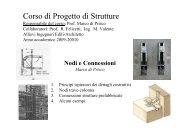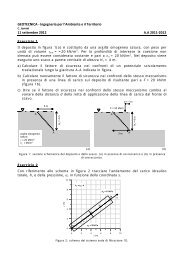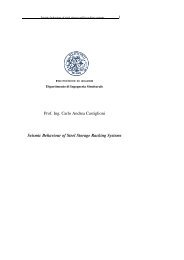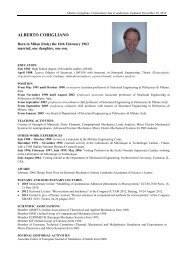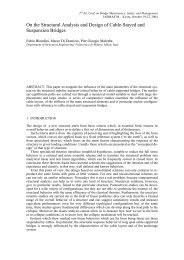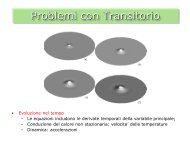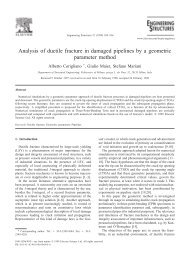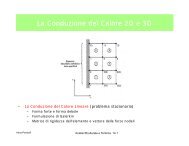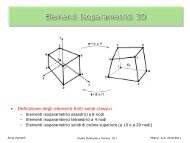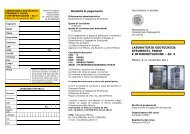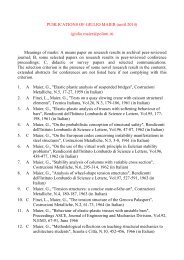a three-dimensional finite beam element for multiscale damage ...
a three-dimensional finite beam element for multiscale damage ...
a three-dimensional finite beam element for multiscale damage ...
- No tags were found...
Create successful ePaper yourself
Turn your PDF publications into a flip-book with our unique Google optimized e-Paper software.
a <strong>damage</strong> index of the <strong>element</strong> Dk = Dk(t):∫Vk∫wDMdVDk==∫ βkDMdV(18)Vw dVkVkand a <strong>damage</strong> index of the structure D = D ) :m∑∫∑∫k = 10 0( twDMdVmVkk = 1D0 ==m ∑∫ β0DMdV(19)Vkk = 1w dVVkThe knowledge of both the time evolution and spatial distribution of such indices can be easily obtainedfrom a <strong>finite</strong> <strong>element</strong> analysis and leads to an accurate measure and a comprehensive vision of thestructural per<strong>for</strong>mance.APPLICATIONSRein<strong>for</strong>ced Concrete Column subjected to Cyclic Biaxial Bending and Axial ForceIn order to verify the capability of the proposed <strong>three</strong>-<strong>dimensional</strong> <strong>finite</strong> <strong>beam</strong> <strong>element</strong> in reproducing thecyclic response of rein<strong>for</strong>ced concrete systems under complex loading histories, the results of a series ofexperimental tests carried out by Bousias et al. (1995) are considered. The experimentation consists ofcyclic static tests on rein<strong>for</strong>ced concrete columns subjected to a vertical load and horizontal imposeddisplacements. In the present application, the tests denoted with S1, S5, S7, and S9 only are considered.All the columns have a free height h = 1.49 m and a square cross-section with side dimensiona = 250 mm (Figure 6.a). The rein<strong>for</strong>cement consists of 8∅16 mm longitudinal bars with concrete coverc = 15 mm, and stirrups ∅8 mm with spacing s = 70 mm. The steel material properties are: yielding strengthf sy = 460 MPa; ultimate strength f su = 710 MPa; ultimate strain ε su = 11%. The compression strength of concretevaries with the specimen: (S1) f c0 =29.0 MPa; (S5) f c0 =33.1 MPa; (S7) f c0 =28.1 MPa; (S9) f c0 =23.9 MPa.3For concrete the following properties are also specified:12 3E c 0= 9500 f c0, fct= 0.25fc0, ε c0 = 2%, ε cu = 4%.The components of the displacement at the top of the column and of the corresponding reaction<strong>for</strong>ce at its base are denoted with (u x ,u y ,u z ) and (F x ,F y ,F z ), respectively, where x and y are the horizontaldirections along the principal axes of the cross-section and z is the vertical direction along the axis of thecolumn. The displacement loading histories u x – u y are shown in Figure 7. As recalled in such Figure, thetests S1, S5, and S7 were carried out with a constant axial load ν =N/(f c0 a 2 ) = 0.12, while <strong>for</strong> the test S9two levels of axial load, ν = 0.03 and ν = 0.15, were applied during the experiment. Moreover, in order toavoid second order effects on the reaction <strong>for</strong>ce, the axial load was applied in such a way that its line ofaction passed at each time instant through the center of gravity of the column base.The column is modeled with 4 <strong>finite</strong> <strong>beam</strong> <strong>element</strong>s, each of them with 7 Gauss-Lobatto sections.The cross-section is subdivided in 13 isoparametric sub-domains, each of them characterized by adifferent level of confinement (Figure 6.b) and by an integration scheme which varies from 2×2 to 5×5Gauss-Legendre points (Figure 6.c), <strong>for</strong> a total of 93 sample points.Figures 8.a-b show the results of the analyses superimposed to those obtained from the experiments.In particular, the time-history of the vertical displacement u z =u z (t), the path of the horizontal reaction <strong>for</strong>cesF x -F y , and the horizontal load-displacement diagrams F x -u x and F y -u y , are reproduced in such Figures. In allcases, the comparison between numerical and experimental results is in general very good, even if minorsystematic deviations are noted in the initial branch of the first cycle of the load-displacement diagrams, aswell as along the reloading branches in correspondence of the sign inversion of the <strong>for</strong>ces, where the numericalhysteretic cycles tend to be a little wider than the experimental ones. Higher and not negligible deviationshowever occur during the last phases of the tests S5 and S9, which are characterized by a relevant strengthdegradation that is not detected by the numerical analyses. Since this is the only remarkable discrepancyamong analyses and experiments, it seems reasonable to correlate the strength degradation process with failuremechanisms which the <strong>finite</strong> <strong>beam</strong> <strong>element</strong> is not able to reproduce, as <strong>for</strong> example bond-slip and pull-outphenomena (Filippou 1998). Shear failures should be instead avoided due to the slenderness of the column.




